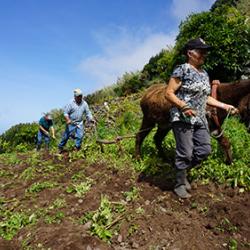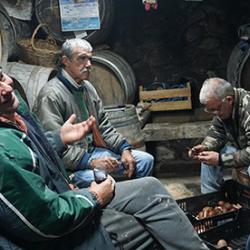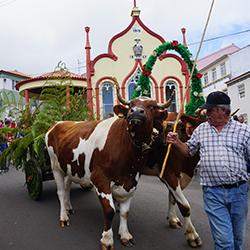Tim Burger: Agriculture in a Depopulated Place
How does it feel to cultivate land perceived as already ‘lost’? I spent much of my fieldwork on São Jorge Island, Azores, with small-scale farmers who believe that their livelihoods are becoming increasingly impossible to maintain: outmigration has drained the working population, fertile topsoil is eroding, agrarian subsidies are focused only on dairy livestock.
These structural conditions converge for many farmers in the emblematic figure of ‘lost’ land (terra perdida). As the terraced fields are gradually abandoned for a lack of labour, they are soon overgrown by brushwood. Watching the forested slopes slowly approach their villages, islanders perceive the sight and feel of vanishing property as fundamentally distressing. The withered population coupled with the changed landscape causes a situation in which their surrounding fails to make sense to them. While engaging in a resigned rhetoric about this predicament, farmers nonetheless respond with vibrant and defiant horticultural action.
Keeping fields under cultivation, producing and consuming wine, or celebrating powerful draft animals, all practically enact many people’s understanding of desirable agrarian sociality. These images try to capture how farmers live out their experience of depopulation along such practical lines.
Ploughing a ‘Lost’ Piece of Land
The photo depicts three siblings tilling a terraced field that might soon be overgrown by brushwood. They use a donkey drawn plough to unearth potatoes and immediately seed corn into the same furrow. Knowing that they are likely going to be the last generation to cultivate this land, the three still stress the ‘beauty’ (beleza) of harvesting their potatoes while keeping the dispersed family together.
Men in Conversation
Several men have gathered in a so-called adega or wine hut. Especially during the rainy winters, such spaces are hubs for male working-class sociality. Next to facilitating constant conversation and wine consumption, adegas also serve to store and prepare agrarian produce (see centre right). On many occasions, such sociable moments swiftly turn from engaged discussions into fights and physical violence.
Celebrating Oxen and the Holy Ghost
The Holy Ghost Festival (Festa do Espírito Santo) is one of the rare occasions that draws many people from different parts of the island together. In Topo, a peripheral town of the island, a procession is launched that allows cattle farmers to parade their powerful oxen. Horticulturalists who often cannot afford machines or draft animals but must rely on pickaxe, hoe, and hand for their agrarian projects, speak with jealousy and deep admiration of these oxen.
What the Judges said
Evocative images that work very well as an ensemble and alongside the text; very dynamic scenes, capture emotive scenes of a fieldwork, humans and animals close-up; at the same time very successful image composition, multiple layers in each picture, leading lines; life-worldly significance of themes of lost land and holding tight to cultivation find palpable expression in the pictures. Nice diversity in these images, depicting agricultural activity, relaxed conversation, and a festival unfolding, respectively. Image 2 is my favourite – I especially enjoy how animated the man is in the left foreground and appreciate the colour palette of greens, greys, blues, and browns. I appreciate seeing the way animals are utilized in images 1 and 3 and the sense of motion in both of these shots. The varied expressions in the faces of the men and their stances captured in the second image drew my attention. The accompanying text also helps make sense of this. As a whole, the collection of images evoke the complex relationship between humans, land and animals that the student’s project explores.



